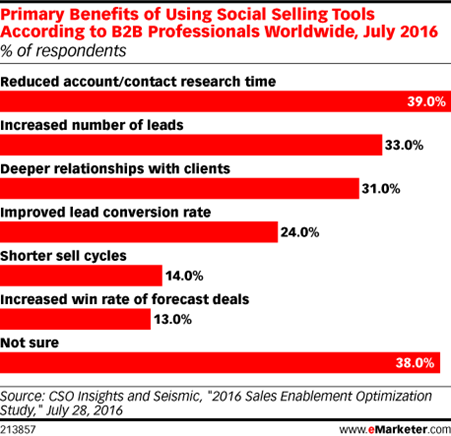Social selling is a relatively new phenomena that is based on a combination of having well-oiled, researchable professional social media channels (e.g. LinkedIn, Twitter); identified leads (potential customers) with B2B Lead generation software such as Leadberry; and having a sales team that proactively goes after contacts – based on Google Analytics data.
LinkedIn had 500 million users from more than 200 countries in April 2017. It lists more than 9 million companies, according to a blog post by Aatif Awan, vice president of growth and international products for the Mountain View, Calif.-based company.
What is Social Selling?
Social selling enables sales people to pinpoint their leads (prospecting) and establish trust through their existing network of connections. If this sounds more motivating than cold calling, we agree with you: it is. “Social selling is the art of using social networks to find, connect with, understand, and nurture sales prospects. It’s the modern way to develop meaningful relationships with potential customers that keep you—and your brand—front of mind, so you’re the natural first point of contact when a prospect is ready to buy.” says Christina Newberry of Hootsuite.
Perhaps the most important thing to remember about social selling is sales people’s ability to "listen in" on an online conversation between users of your product and build relationships with them to be able to sell to them at the right time. Everyone has problems they want to solve, so it’s only logical to offer solutions to these problems whenever the problem becomes "visible". So make your prospects lives’ easier by offering solutions to them.
Social selling’s primary benefits include reduced account/contact research time; increased number of leads; deeper relationships with clients; improved lead conversation rate; shorter sell cycles; and increased win rate of forecast deals.
Trust is perhaps the biggest advantage, when it comes to social selling: 87 percent of B2B buyers say they would have a favorable impression of someone introduced through their professional network.

And of course, there is a demand side of the equation as well: buyers also do their fare share of the research before committing to buy anything. IDC found that 75 percent of B2B buyers and 84 percent of executives use contacts and information from social networks as part of their purchase process.
How to be successful with social selling?
Social selling isn’t rocket science. Rather, it’s the combination of
- using a B2B lead generation software, such as Leadberry to identify visitors to your B2B website and creating leads from them.
- This part is easy: sign-up to a 30-day free trial with Leadberry, hook up Leadberry with your website and you are all sorted. You will receive B2B leads (based on visitors who visited your website) that include company names, people to contact with. Emails, social profiles, and a whole bunch of extras that’ll have you say "wow!" instantly.
- Next, have a professional looking company profile and employee profile(s) on LinkedIn. This is all the more important, as you want people you reach out to, think that you are an expert in your field.
- Don’t forget to post about topics that are of interest for your leads: not about your own products, rather about a broader topic your service/product is also a part of. So if you are in soft-skills training, post about the importance of having a well-trained work-force and the benefits of having engaged employees. Trust us, people reading your posts will not forget your efforts, and will contact you when they come about to purchasing specific training courses.
- Make sure your profile and posts are keyword optimized, as LinkedIn works similarly to Google: keywords make the world go round, and if you want to be found, put in a little extra thought into inserting keywords that your target audience is likely to search for.
- Use social lists to monitor what people are saying about you, your company, your industry, and your competitors. Watch for pain points and requests for recommendations, both of which provide natural opportunities for you to provide the solution to a problem.
- When you get to the point of interacting with your prospects on social networks, try not to get too "pitchy". Provide your potential customers valuable information that will help them see you as an expert in your field. You don’t have to go it all alone: share relevant posts from others with your customers – but give credit to others.
- When using LinkedIn, make sure you appear credible to others: ask for recommendations, and display your results (of your efforts in your job role). All too many people suffice with displaying their job role as a job description in a bullet point style, instead of boasting about what they achieved already in that position. Be smarter, build credibility!
- Extend your network as much as possible: do this on a daily basis, and pay attention to the "People you may know" reccos of LinkedIn. Start with inviting people from your own email contacts, than go broader and get in touch with people from similar positions as yourself and last but not least reach out strategically to those you think will/could become your customers. These are the people you can help the most.
- There are now excellent software tools for social selling: try Hootsuite’s Amplify for example.
We hope you found this post useful. If you have any comments, ideas, please drop us a line!
